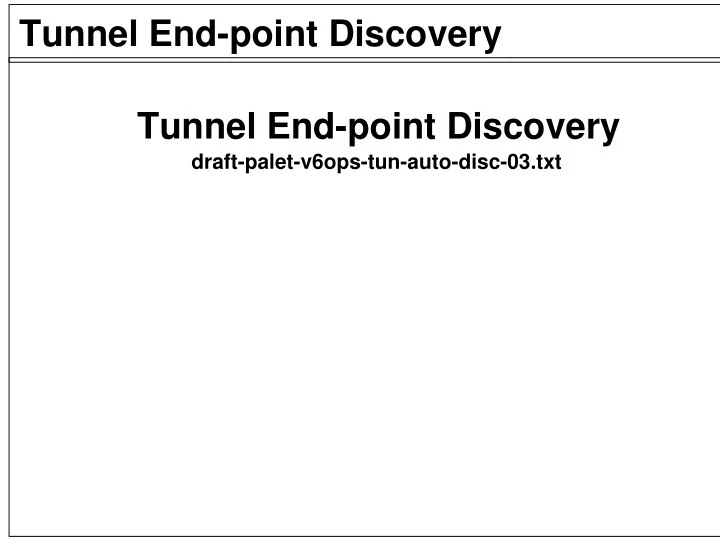

Tunnel End-point Discovery Tunnel End-point Discovery draft-palet-v6ops-tun-auto-disc-03.txt
Tunnel End-point Discovery IPv6-in-IPv4 Tunnel End-point Discovery Is this something we have to provide? A different discussion.. Scope of the Discovery Only in network of the ISP where the user attaches to "Third party" discovery is out of scope Assumptions Must work through a (non-upgraded) NAT/router The user may have his own NAT/router box(es) IP addresses may be private and/or dynamic Proposed solutions Well-known unicast address ("anycast") for initial discovery DNS (in forward or reverse tree) DHCP and PPP options SLP
Tunnel End-point Discovery TEP Discovery - anycast Main properties Well-known v4 unicast address ("anycast") Only for initial discovery of the "real" unicast address Typically would not be advertised in eBGP Advantages Works through NATs, etc. very well Seems to work based on DNS root anycast and 6to4 anycast Disadvantages ISPs need to be careful in filtering the prefix to prevent hijacks Applies to those ISPs who provide the service Routing operations may be more difficult e.g. in enterprises than changing DNS
Tunnel End-point Discovery TEP Discovery - forward DNS Main properties Use of DNS search path to discover _v6tc.example.com DNS search path learned through DHCP, etc. Advantages Adding the tunnel server requires just inserting an A record Disadvantages NAT boxes w/ DHCP pool have to pass through the search path Forward DNS search path and topology do not always map well If no search path, the queries might end up at the root servers
Tunnel End-point Discovery TEP Discovery - reverse DNS Main properties Define a new "TEP" record Prepopulate all the IP addresses of potential clients with the record "1.2.3.4.in-addr.arpa. IN TEP v6tc.example.com" The clients would look up TEP record of their own IP address Advantages Maps well to the topology Disadvantages Assumes prepopulation of the whole IP address space DNS operations pain unless the IP address space mgmt scripts can be modified? Assumes that all RFC1918 space is also prepopulated and the box is not authorative for RFC1918 It takes a while to develop a new RR type.
Tunnel End-point Discovery TEP Discovery - DHCP or PPP Main properties Define a new DHCPv4 or PPP option to carry the information Advantages DHCPv4 options are easily defined, "de facto" config method Disadvantages Does not work through non-upgraded NAT/router boxes Sufficient number of users don’t run DHCP or PPP Would have to define multiple options There has been resistance to new PPP options
Tunnel End-point Discovery TEP Discovery - SLP Main properties Use Service Location Protocol Advantages Not really any, except the spec is out there... Disadvantages Multicast cannot be assumed, so a Directory Agent needed Then, configuring the address of DA is a problem (e.g. DHCP) Back to square one..
Tunnel End-point Discovery TEP Discovery - Summary/Discussion If this must work through non-upgraded NAT boxes.. DHCP and PPP are non-starters Forward DNS may have issues, are these serious enough? What’s left? Well-known unicast address Reverse DNS prepopulation� Manual configuration.. (obviously) Where to go next?
Recommend
More recommend